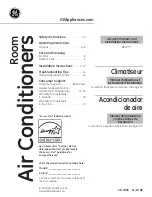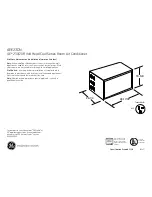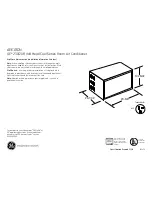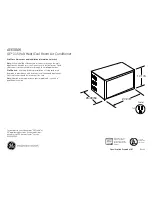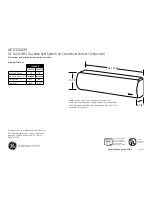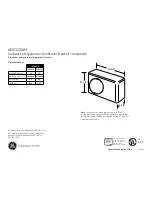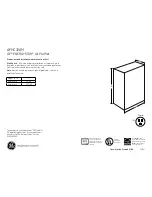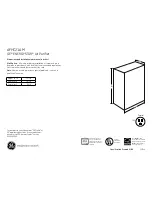
13
PRE--START--UP
ENVIRONMENTAL,
FIRE,
EXPLOSION,
ELECTRICAL SHOCK HAZARD
Failure to follow this warning could result in personal
injury or death.
1. Follow recognized safety practices and wear protective
goggles when checking or servicing refrigerant system.
2. Do not operate compressor or provide any electric power
to unit unless compressor plug is in place and secured.
3. Do not remove ccompressor plug until all electrical
sources are disconnected and tagged.
4. Relieve and recover all refrigerant from system before
touching or disturbing compressor plug if refrigerant
leak is suspected around compressor terminals.
5. Never attempt to repair soldered connection while
refrigerant system is under pressure.
6. Do not use torch to remove any component. System
contains oil and refrigerant under pressure.
To remove a component, wear protective goggles and
proceed as follows:
a. Shut off electrical power to unit and install
lockout tag.
b. Relieve and reclaim all refrigerant from system
using both high-- and low--pressure ports.
c. Cut component connecting tubing with tubing
cutter and remove component from unit.
d. Carefully unsweat remaining tubing stubs when
necessary. Oil can ignite when exposed to torch
flame.
!
WARNING
Use the Start--Up Checklist supplied at the end of this book and
proceed as follows to inspect and prepare the unit for initial
start--up:
1. Remove access panels (see Fig. 19).
2. Read and follow instructions on all DANGER, WARNING,
CAUTION, and INFORMATION labels attached to, or
shipped with unit.
3. Make the following inspections:
a. Inspect for shipping and handling damage, such as
broken lines, loose parts, disconnected wires, etc.
b. Inspect for oil at all refrigerant tubing connections and
on unit base. Detecting oil generally indicates a
refrigerant leak.
c. Leak--test all refrigerant tubing connections using
electronic leak detector, or liquid--soap solution. If a
refrigerant leak is detected, see following Check for
Refrigerant Leaks section.
d. Inspect all field-- and factory--wiring connections. Be
sure that connections are completed and tight.
e. Ensure wires do not touch refrigerant tubing or sharp
sheet metal edges.
f. Inspect coil fins. If damaged during shipping and
handling, carefully straighten fins with a fin comb.
FIRE, EXPLOSION HAZARD
Failure to follow this warning could result in personal
injury, death or property damage.
Do not purge gas supply into the combustion chamber. Do
not use a match or other open flame to check for gas leaks.
Use a commercially available soap solution made
specifically for the detection of leaks to check all
connections.
!
WARNING
4. Verify the following conditions:
a. Make sure gas line is free of air. Before lighting the unit
for the first time, perform the following with the gas
valve in the OFF position:
NOTE
: If the gas supply pipe was not purged before connecting
the unit, it will be full of air. It is recommended that the ground
joint union be loosened, and the supply line be allowed to purge
until the odor of gas is detected. Never purge gas lines into a
combustion chamber. Immediately upon detection of gas odor,
retighten the union. Allow 5 minutes to elapse, then light unit.
b. Ensure fan hub is positioned correctly with respect to
motor housing.
c. Make sure that air filter(s) is in place.
d. Make sure that condensate drain trap is filled with water
to ensure proper drainage.
e. Make sure that all tools and miscellaneous loose parts
have been removed.
START--UP
Step 1 — Check for Refrigerant Leaks
Proceed as follows to locate and repair a refrigerant leak and to
charge the unit:
1. Locate leak and make sure that refrigerant system pressure
has been relieved and reclaimed from both high-- and
low--pressure ports.
2. Repair leak following accepted practices.
NOTE
: Install a filter drier whenever the system has been opened
for repair.
3. Add a small charge of Puron (R--410A) refrigerant vapor to
system and leak--test unit.
4. Recover refrigerant from refrigerant system and evacuate to
500 microns if no additional leaks are found.
5. Charge unit with Puron (R--410A) refrigerant, using an
accurate scale. Refer to unit rating plate for required charge.
Step 2 — Start--up Heating and Make Adjust-
ments
Complete the required procedures given in the Pre--Start--Up
section before starting the unit. Do not jumper any safety devices
when operating the unit. Make sure that burner orifices are
properly aligned. Unstable operation my occur when the burner
orifices in the manifold are misaligned.
Follow the lighting instructions on the heating section operation
label (located on the inside of the control access panel) to start the
heating section.
574D
--
--
A
Summary of Contents for 574D----A
Page 3: ...3 A09469 Fig 2 574D A24 36 Unit Dimensions 574D A ...
Page 4: ...4 A09470 Fig 3 574D A42 60 Unit Dimensions 574D A ...
Page 16: ...16 A09282 Fig 14 208 230 1 60 Connection Wiring Diagram 574D A ...
Page 17: ...17 A09282 Fig 14 Cont 208 230 1 60 Ladder Wiring Diagram 574D A ...
Page 18: ...18 A09264 Fig 15 208 230 3 60 Connection Wiring Diagram 574D A ...
Page 19: ...19 A09264 Fig 15 Cont 208 230 3 60 Ladder Wiring Diagram 574D A ...
Page 20: ...20 A09265 Fig 16 460 3 60 Connection Wiring Diagram 574D A ...
Page 21: ...21 A09265 Fig 16 Cont 460 3 60 Ladder Wiring Diagram 574D A ...
Page 25: ...25 Table 7 Cooling Charging Chart A08490 574D A ...
Page 50: ...50 A10098 Fig 45 Economizer Wiring Diagram 574D A ...
Page 51: ...51 A10075 Fig 46 Connection Wiring Diagram 230 3 574D A ...
Page 52: ...52 A10075 Fig 46 Cont Ladder Wiring Diagram 230 3 574D A ...
Page 53: ...53 A10087 Fig 47 Connection Wiring Diagram 460 3 574D A ...
Page 54: ...54 A10087 Fig 48 Ladder Wiring Diagram 460 3 574D A ...
Page 58: ...58 A10064 Fig 49 574D A 30 36 3 Phase with Economizer 574D A ...
Page 59: ...59 A10065 Fig 50 574D A 42 60 3 Phase with Economizer 574D A ...
































